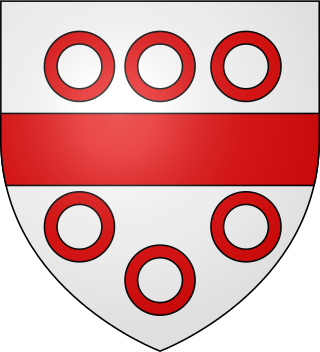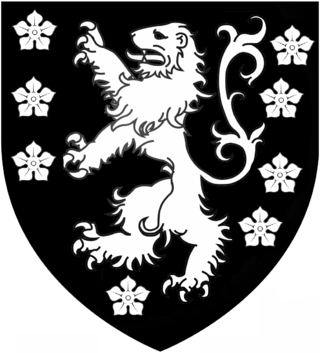
Earl of Warwick is one of the most prestigious titles in the peerages of the United Kingdom. The title has been created four times in English history, and the name refers to Warwick Castle and the town of Warwick.

Earl of Tankerville is a noble title drawn from Tancarville in Normandy. The title has been created three times: twice in the Peerage of England, and once in the Peerage of Great Britain for Charles Bennet, 2nd Baron Ossulston. His father, John Bennett, 1st Baron Ossulston, was the elder brother of Henry Bennett, 1st Earl of Arlington. The family seat was Chillingham Castle in Northumberland.

Baron Hastings is a title that has been created three times. The first creation was in the Peerage of England in 1290, and is extant. The second creation was in the Peerage of England in 1299, and became extinct on the death of the first holder in c. 1314. The third creation was in the Peerage of England in 1461, and has been in abeyance since 1960.

Baron Lucas is a title that has been created twice in the Peerage of England. The second creation is extant and is currently held with the title Lord Dingwall in the Peerage of Scotland.

Earl of Strafford is a title that has been created three times in English and British history.
Baron Ravensworth, of Ravensworth Castle in the County Palatine of Durham and of Eslington Park in the County of Northumberland, is a title in the Peerage of the United Kingdom.

Earl of Sunderland is a title that has been created twice in the Peerage of England. The first creation came in 1627 in favour of Emanuel Scrope, 11th Baron Scrope of Bolton. The earldom became extinct on his death in 1630 while the barony became either extinct or dormant. The second creation came in 1643 in favour of the Royalist soldier Henry Spencer, 3rd Baron Spencer of Wormleighton. The Spencer family descended from Sir John Spencer who acquired the Wormleighton estate in Warwickshire and the Althorp estate in Northamptonshire. His grandson Sir John Spencer was a Knight of the Shire for Northamptonshire. The latter's grandson Sir Robert Spencer represented Brackley in Parliament in the late 16th century. In 1603 Sir Robert was raised to the Peerage of England as Baron Spencer of Wormleighton. He was succeeded by his eldest surviving son, William, the second Baron. He had previously represented Northamptonshire in Parliament. His eldest son was the aforementioned third Baron. In July 1643 he was created Earl of Sunderland in the Peerage of England. Lord Sunderland was killed at the Battle of Newbury in September of the same year. He was succeeded by his two-year-old only son, Robert, the second Earl. He later gained great distinction as a statesman and notably served four times as Secretary of State for the Southern Department.

Marquess of Ripon, in the County of York, was a title in the Peerage of the United Kingdom. It was created in 1871 for the Liberal politician George Robinson, 2nd Earl of Ripon.

Marquess of Hastings was a title in the Peerage of the United Kingdom. It was created on 6 December 1816 for Francis Rawdon-Hastings, 2nd Earl of Moira.

The title Marquess of Halifax was created in the Peerage of England in 1682 for the George Savile, 1st Earl of Halifax.

Earl Cowper was a title in the Peerage of Great Britain. It was created in 1718 by George I for William Cowper, 1st Baron Cowper, his first Lord Chancellor, with remainder in default of male issue of his own to his younger brother, Spencer Cowper. Cowper had already been created Baron Cowper of Wingham in the County of Kent, in the Peerage of England on 14 December 1706, with normal remainder to the heirs male of his body, and was made Viscount Fordwich, in the County of Kent, at the same time as he was given the earldom, also Peerage of Great Britain and with similar remainder. He was the great-grandson of William Cowper, who was created a Baronet, of Ratling Court in the County of Kent, in the Baronetage of England on 4 March 1642. The latter was succeeded by his grandson, the second Baronet. He represented Hertford in Parliament. He was succeeded by his eldest son, the aforementioned William Cowper, the third Baronet, who was elevated to the peerage as Baron Cowper in 1706 and made Earl Cowper in 1718. In 1706 Lord Cowper married as his second wife Mary Clavering, daughter of John Clavering, of Chopwell, County Durham.

Earl of Norwich was a title that was created four times in British history, three times in the Peerage of England and once in the Peerage of Great Britain. The first creation came in the Peerage of England in 1626 in favour of the courtier and politician Edward Denny, 1st Baron Denny. He had already been created Baron Denny, of Waltham in the County of Essex, in 1604, also in the Peerage of England. Lord Norwich was the grandson of Sir Anthony Denny, confidant of Henry VIII, and the nephew of Sir Edward Denny. He had no sons and the titles became extinct on his death in 1630.

Baron Clifton, of Leighton Bromswold in the County of Huntingdon, is a title in the Peerage of England. It was created in 1608 for Sir Gervase Clifton, who made Prebendal house which was built by John Thorpe and later owned by the Clifton baronets branch of the family. The peerage was created by writ, which means that it can descend through both male and female lines. Lord Clifton died without surviving male issue and was succeeded by his daughter Katherine, the second Baroness. She married Esmé Stewart, 3rd Duke of Lennox. They were both succeeded by their eldest son James, the fourth Duke and third Baron. When he died the titles passed to his son, the fifth Duke and fourth Baron. On his death in 1660 at the age of 11, the barony separated from the dukedom. The barony was inherited by the late Duke's sister Mary, the fifth Baroness. She married Richard Butler, 1st Earl of Arran, but died aged only 18. She was succeeded by her first cousin the sixth Duke of Lennox, who became the sixth Baron Clifton as well. He was the son of Lord George Stuart, the fourth son of the third Duke and the second Baroness Clifton. On his death, the barony and dukedom again separated.

Earl of Bellomont, in the Kingdom of Ireland, was a title that was created three times in the Peerage of Ireland. The first creation came on 9 December 1680 when Charles Kirkhoven, 1st Baron Wotton, was made Earl of Bellomont. He had already been created Baron Wotton, of Wotton in the County of Kent, in the Peerage of England on 31 August 1650. He was childless and both titles became extinct on his death in 1683.

Baron Wentworth is a title in the Peerage of England. It was created in 1529 for Thomas Wentworth, who was also de jure sixth Baron le Despencer of the 1387 creation. The title was created by writ, which means that it can descend via female lines.

There have been three baronetcies created for members of the Grey family, one in the Baronetage of England, one in the Baronetage of Great Britain and one in the Baronetage of the United Kingdom. Two of the creations are extant as of 2007.

Ford Grey, 1st Earl of Tankerville, PC was an English peer and politician.
Ralph Grey, 4th Baron Grey of Werke was an English peer who served as Governor of Barbados and as one of the English commissioners for the negotiations on the Treaty of Union between England and Scotland.
Heaton Castle in the parish of Cornhill-on-Tweed, Northumberland, England, is a ruined historic castle near the Scottish border.

Ralph Grey, 2nd Baron Grey of Werke was an English peer.













